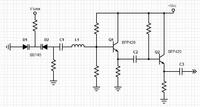Terminator3
Advanced Member level 3

I am trying to design 5GHz oscillator. I am currently calculate stability and reflection coefficients for BFP420 and NE3210S01. Problem is BFP420 is too stable for series feedback. And NE3210S01 have too much gain, and have unstability problems at higher frequencies. So i am searching for some "unstable" transistor with less gain than NE3210S01, but more unstable than BFP420.



